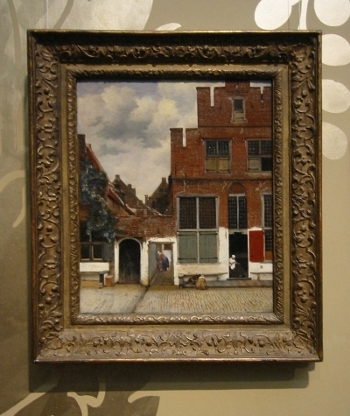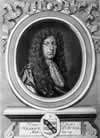The Little Street
(Het Straatje)c. 1657–1661
Oil on canvas, 54.3 x 44 cm. (21 3/8 x 17 3/8 in.)
Rijksmuseum, Amsterdam
inv. A2860
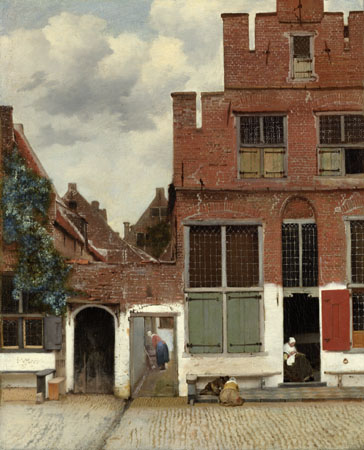
The textual material contained in the Essential Vermeer Interactive Catalogue would fill a hefty-sized book, and is enhanced by more than 1,000 corollary images. In order to use the catalogue most advantageously:
1. Scroll your mouse over the painting to a point of particular interest. Relative information and images will slide into the box located to the right of the painting. To fix and scroll the slide-in information, single click on area of interest. To release the slide-in information, single-click the "dismiss" buttton and continue exploring.
2. To access Special Topics and Fact Sheet information and accessory images, single-click any list item. To release slide-in information, click on any list item and continue exploring.
The children at play
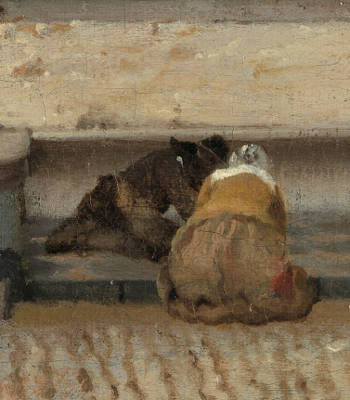
One of the most poignant details in Vermeer's oeuvre is the image of two children absorbed in play in The Little Street. Even though they occupy a small portion of the canvas, the magical atmosphere of the piece would lose much of its intimate allure without them. In true Vermeer style, the nature of the children's play and their facial expressions remain a mystery. We can reasonably infer from the dark clothing and broad-brimmed hat of one child that he is likely a boy, while the attire of the other suggests she is a girl. By keeping their activities hidden and their backs turned to us, Vermeer encourages the observer to delve into memories and feelings from their own youth. Consequently, the viewer becomes an engaged contributor to the artwork's subtle storytelling, rounding it out as a masterpiece.
In the 17th century, once children were out of their infancy, they were often dressed as scaled-down versions of adults. This fashion might indicate a diminished acknowledgement of a child's distinct identity, especially when compared to today's middle-class standards. Interestingly, both boys and girls typically wore the same ankle-length dress, with boys donning them until about 5 to 7 years old. Given the high cost of clothing, many children wore hand-me-downs. Without a provided name, modern observers examining period portraits of children may find it challenging to discern a child's gender before they reached the age of breeching. A common protective layer was the pinafore, an apron-like garment affixed over a decorative dress.
The European elite typically started their children's education under the guidance of tutors or governesses from around 3 years old. Contemporary letters and journals reveal that this education began so early and intensively that it wasn't uncommon for 4 or 5-year-olds to read, write and comprehend multiple languages.
The depth of emotion in Vermeer's depiction gains further resonance when we consider his own familial experiences. Vermeer was the father to eleven children: Maria, Elisabeth, Cornelia, Aleydis, Beatrix, Johannes, Gertruy, Franciscus, Catharina, Ignatius and another child of unknown name. Tragically, four did not survive past their early years.
The cloudy sky

The quiet scene of the present composition is bathed in a luminous penumbra created by unseen overhead cumulus clouds. The clouds themselves, illuminated by soft sunlight coming from the left, exhibit a painterly style, where the quick handling of the brush can be observed up close, unlike the softer and more subtle handling of the clouds in his View of Delft.
Dutch painters, especially during the Golden Age of Dutch art, had a deep understanding and unique sensibility for the nuanced complexities of nature, capturing its contrasts and delicacies with unparalleled skill. Their landscapes often showcased vast, atmospheric skies with clouds that seemed to almost float off the canvas. These pictures reflected the Netherlands' maritime climate and expansive horizons and showed off the artists' exceptional observational capabilities and mastery of their medium.
To achieve the characteristic luminosity and depth in their skies, Dutch artists often employed a multi-layer system. By layering thin, translucent paint, rather than placing colors side by side in one go, they infused their skies with an ethereal quality. The soft transitions between the sky's cerulean blues and the fluffy whites of the clouds were achieved with a fan or badger brush, producing the smooth gradations essential for expressing nature's vastness.
The primary pigment for the blue sky in The Little Street is azurite, a popular blue used by 17th-century Dutch painters. He used the more expensive natural ultramarine for the blue sky of the more ambitious View of Delft. The clouds in The Little Street are skillfully and quickly rendered using diagonal brushstrokes of a creamy white admixed with hints of red ochre and azurite for the light shadows. The use of red ochre for coloring the shadows of the clouds is unusual—shadows of clouds are typically rendered with white and black—but they are so pale that the red is not readily perceived, and it harmonizes with with the buildings which are depicted predominantly rendered with shades of red ochre.
Azurite was a tricky pigment to handle unless used as a light admixture with white, where it becomes far more manageable. To achieve the deep blue typical skies of the Flemish artists, several azurite layers were demanded, resulting in an impressively intense hue. Each tiny particle of the crushed crystalline mineral shimmered like a tiny sapphire, especially before varnishing. However, azurite's coarse texture presented challenges for finer details. Often, it served as an affordable base for the more expensive natural ultramarine, a cherished pigment derived from ground lapis lazuli.
Delft's canals
The rows of worn cobblestones, which gradually converge, play a crucial role in creating depth, drawing the eye to the figural elements of the composition and offsetting the overwhelming flatness of the main facade that dominates the picture plane. It seems that water, perhaps soapy from the servant's washbasin, flows into a gutter running along the wall that separates the adjacent doorways' properties. This water eventually drains into a canal, which remains unseen below the frame. Directly in front of the main building's entrance lies a shallow platform adorned with ceramic tiles arranged diagonally.

Cobblestones, known as kinderkopjes in Dutch (which translates to "children's heads" due to their size and shape), were ubiquitously employed as a final pavement, particularly in urban areas. Unlike bricks or cut stone blocks, cobblestones aren't typically "manufactured" in a traditional sense. Instead, they are collected. In the 17th century, workers would gather these stones directly from riverbeds or from stone quarries, then sort them by size. Sometimes, they might be chipped or shaped to fit more closely together, but for the most part, they retained their natural, rounded shape. The method of laying cobblestones requires a fair amount of skill. The base was usually sand or gravel, compacted and leveled. Stones would be hand-placed tightly together, and finer gravel or sand would be used to fill the spaces between. The cobblestone streets and roads had several advantages. They provided better drainage than unpaved or dirt roads, especially in the often wet climate of the Netherlands. They also resisted wear and tear from cart traffic better than many other types of roads of the time.
Delft boasts a fine network of canals, constituting one of the town's standout features. The name "Delft" itself springs from the term delven, signifying "to dig." Many European travelers observed the Dutch's keen sense of cleanliness. Every morning, residents would meticulously wash the street outside their homes. Such was the purity of Delft's canals that their waters were deemed suitable for beer brewing. A certain visitor once expressed that Delft homes had floors so immaculate, one could dine off them without needing a plate. Notably, the renowned Delft scientist, Antonie van Leeuwenhoek, mentioned cleaning the gutters of his residence biannually.
Hidden symbolism
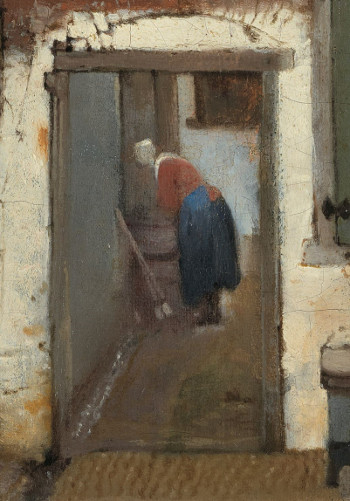
Together with The Milkmaid, the two women depicted in The Little Street are the sole individuals in Vermeer's collection shown engaged in commonplace activities within and around the household. These figures highlight that during the 17th century, family life often unfolded on the threshold of the voorhuis (front hall) and the street. The seamless transition between interior and exterior spaces, as revealed by recent studies of domestic culture in the Dutch Republic, is evident in these depictions. While Vermeer's work captivates the viewer with its lifelike portrayal, seemingly transporting viewers to the mid-17th century in a time capsule, it isn't devoid of symbolic references.
At the end of an anonymous private alleyway—one among hundreds in Delft—a fully clothed maid busies herself, washing laundry over a wooden barrel. Nearby, an idle broom stands, poised for sweeping the pavements with renowned vigor. During the 17th century, sweeping and brooms were deeply associated with spiritual cleanliness and purity, echoing a concept of domestic virtue pivotal to both Christendom and Dutch national identity.
Infrared reflectography discloses an interesting detail: Vermeer originally depicted a seated woman engaged in handiwork at the alleyway's entrance. However, she was painted over in the latter stages, likely because her presence hindered the passageway, detracting from the three-dimensional effect of the allyway, vital to the composition's subtle dynamics.
Grapevines

Grapevines sprawl prominently across many Dutch cityscapes. Despite the inability of Dutch grapes to yield drinkable wine due to limited sunlight, these vines were cherished for their ornamental value. Historically, since the time of Antiquity, vines have stood as symbols of fidelity, marriage and in the context of this piece, domestic virtue. However, it's speculative to assert that Vermeer attributed any symbolic significance to them in this particular painting.
The unusual blue hue tinges the foliage in Vermeer's work is presumably due to phenomenon a missing transparent yellow glaze that was originally applied over the blue leaves, which would have rendered them a more natural green. This glazing technique—layering yellow lake over ultramarine blue—was apparently widespread. The discoloration of yellow lakes in 17th-century Dutch paintings is an important aspect of art history and conservation. The most probable candidate for the faded yellow of the vegetation of The Little Street is weld, a dye derived from the plant Reseda luteola. It was also colloquially known as schijtgeel in Dutch, which translates somewhat crudely to "shit yellow." This moniker was likely given due to its propensity to fade quickly.
To extract the vibrant hue from Reseda luteola, it's best to harvest the plant just before it flowers, although all above-ground parts are usable. Once harvested, the plant is chopped and soaked in water. This material is then boiled to release the yellow dye. After straining out the plant remnants, a mordant, typically alum, is added to ensure the dye's adherence and longevity on materials like fabric. For painting purposes, the dye is precipitated onto a substrate like white clay or chalk to form a pigment powder. This powder can then be mixed with binders, such as oil or egg, to make paint.
The elderly woman sitting in the doorway

The elderly woman, who keeps a quiet vigil over the scene, appears to be engaged in some form of needlework, likely sewing, given the sizable cloth draped over her lap. Remarkably, she is the sole aged figure within the artist's entire oeuvre, even though such characters were a staple among Dutch painters of that era. Activities like sewing and spinning were often seen as symbols of domestic virtue with Biblical roots. Thus, Vermeer's picture represents a real situation that serves as a model of behavior. However, the work is so naturalistic in its appearance that the viewer never feels the weight of didacticism or moralizing finger-waving.
Contrary to the rest of Europe, homes in the Netherlands grew in importance and was eventually embodied in an emblem from the popular emblem book Sinnepoppen by Roemer Visscher. One emblem displays a turtle inside its shell, symbolizing the notion of never departing from one's home, accompanied by the caption "T'huys best"— translating to "home is best." This virtuous domestic setting wasn't just symbolic; it was politically pertinent, often described as "the seed of the state."
Artistic license
According to Vermeer expert, Arthur K. Wheelock Jr., despite Vermeer's penchant for realistic effects, the architectural design of the building on the right suggests that the artist might have taken liberties with reality. On one hand, historical sources from Amsterdam indicate that during the 17th century, shutters typically sported green exteriors and red interiors, as Vermeer depicted. However, the green and red shutters in the painting differ not just in color.
Moreover, from the parts of the house Vermeer portrayed, it appears to be symmetrically organized: two double windows flank a central door on the ground floor, while the first floor has two smaller double windows, and there's a single window centered on the top floor. But a closer look reveals that the windows on the first floor aren't equally spaced from the central door. The window on the right is even taller than the double windows on the left. Furthermore, the reddish-orange shutter suggests that the windows on the door's right are more narrow compared to the ones on the left.
These architectural anomalies likely underscore Vermeer's intentional modifications for artistic composition. Microscopic examinations and infrared reflectography have shown that Vermeer painted the red shutter atop the white layer of the neighboring facade. This suggests that the currently open shutter wasn't part of his original design. A reflectogram of the window just above it on the first floor reveals that initially, only the left half of the shutter was marked in a lighter shade. Given that this shutter features two iron bars, it's inferred that Vermeer initially painted the shutter as half-open but later decided to depict it as closed.
Familiar benches
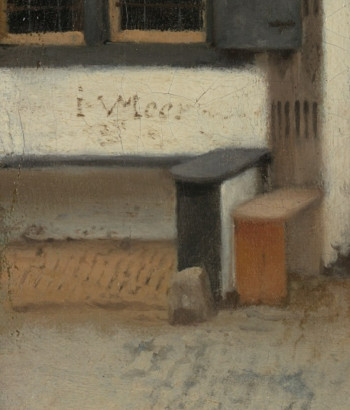
The placement of benches outside houses was indicative of the close-knit nature of Dutch neighborhoods. They served as gathering spots for social interaction. Homes were often built with their facades directly facing the street, blurring the line between private and public spaces. Benches were an extension of this, creating shared areas where people could engage in informal conversations with neighbors, observe the bustling street life and connect with the passersby.
An old house, even in Vermeer's time
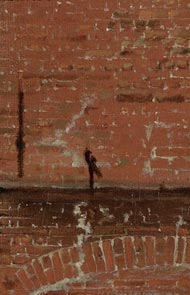
According to historians of architecture, Vermeer depicted a house that dated from the second half of the 15th or the beginning of the 16th century. It was not the kind of luxurious townhouse inhabited by the privileged elite of Delft, but rather a dwelling for modest folk. It had high ceilings, well-lit rooms and unusual step-gables, making it one of the surviving medieval houses of the time.
The area where the house stood was spared by the Great Fire of 1536, which had destroyed a considerable part of Delft. The building shows numerous repaintings and patches for cracks that may have been inflicted by another civic calamity: the infamous event known as the Thunderclap of 1654 when an ammunition magazine exploded, killing hundreds of inhabitants.
Even though everyone who has seen the painting in person is astonished by the genuine appearance of a single place, several art historians believe that Vermeer created a composite of different buildings. This 17th-century "copy-and-paste" practice was hardly an anomaly. Pieter de Hooch, for example, painted two courtyards in Delft that are nearly identical at first glance, except for their varied architectural features. The ability to combine pieces of reality in a skillful manner would have been admired by contemporary viewers.
Despite its artifice, Vermeer's Little Street remains one of the most naturalistic renditions of a 17th-century Dutch townscape. Even though it is rendered with breathtaking attention to detail, the finished image shares little with the dry, topographic tradition of contemporary landscape painting. Moreover, the main building is unusually off-center and cropped at the top, which enhances the sense of immediacy by presenting a point of view from which the viewer cannot escape. Thus, it is unlikely that it was conceived as a commemorative "portrait" of a specific house. The French artist and writer, Eugène Fromentin, wrote that if there ever was a portrait of Holland, The Little Street epitomizes it.
Vermeer expert Arthur K. Wheelock Jr. noted that the buildings in the painting have no distinct architectural features, wall plaques, or signs. Furthermore, no church spires rise in the background, making it challenging for the modern viewer to pinpoint their exact location. Vermeer's perspective is less about Delft or even a specific fragment of a streetscape in Delft and more about the poetic beauty of everyday life.
special topics
- Where is Vermeer's scene?
- Vermeer's childhood
- The public lives of Dutch women
- 17th-century tourism in Delft
- Dutch children
- Dutch homes
- A view from the back of Mechelen
- The inspiration of Pieter de Hooch
- A "fake" Vermeer cityscape
- Vermeer: a conservative painter for a conservative town
- Jacobus Vrel: follower or precursor?
- Painting bricks
- Schilderachtig and Vermeer's house
- Listen to period music
Critical assessment
Time, halted for this instant and therefore in a sense for eternity, seems to be his essential subject. Its wear and tear is visible in the bricks and mortar, the fabric of fact that bluntly underpins our tenuous and temporary hold with its many unanswerable questions, such as 'What are we doing here?' And yet according to some art historians, the picture is also about the ideals of domestic virtue: the grapevine symbolizes love and marital fidelity. Psalm 128 says: "Thy wife shall be as a fruitful vine by the sides of the house." Catharina was often "full and sweet" as the Dutch described the state of pregnancy. And Vermeer allows for this sense of development in his painting. Unlike de Hooch, who freezes his figures for once and for all, he gives us the feeling that at any moment the woman in the doorway will put her sewing or embroidery away and call to the children; time for some food. And the servant will come in from the passageway and help in the kitchen.
Vermeer: A View of Delft, Anthony Bailey, 2001
The signature

inscribed below window at left: i VMeer (VM in ligature)
(Click here to access a complete study of Vermeer's signatures.)
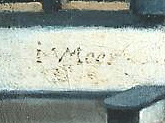
Dates
1661 Albert Blankert, Vermeer: 1632–1675, 1975
c. 1657–1658
Arthur K. Wheelock Jr., The Public and the Private in the Age of Vermeer, London, 2000
c. 1659–1661
Walter Liedtke, Vermeer: The Complete Paintings, New York, 2008
c. 1659–1660
Wayne Franits, Vermeer, 2015
(Click here to access a complete study of the dates of Vermeer's paintings).
Technical report
The support is a fine, plain weave linen, with a thread count of 14 x 14 per cm² The original tacking edges are present and marks from the original strainer bars are 3.5 cm. from the edge on all sides. Of the two lining canvases one is probably attached with glue/paste, the other with wax resin.
The gray ground visible along the silhouette of the right house and in parts of the brick façade contains umber, a little chalk and lead white. Coarse particles of lead white protrude through the thin paint layers of the façade and in the brown shadows. Along the left edge of the painting secondary cusping is evident.
The sky was underpainted with lead white, over which the chimneys on the v-shaped-roofline were painted. Azurite was used in the underpainting of the three upper windows, including sills and surrounds, of the right house, followed by a creamy yellow layer. The sequence of paint layers is reversed in the ground-floor windows of this house. The foliage was painted with an azurite and lead tin-yellow mixture, three different shades of an ultramarine and lead white mixture and pure ultramarine.
* Johannes Vermeer (exh. cat., National Gallery of Art and Royal Cabinet of Paintings Mauritshuis - Washington and The Hague, 1995, edited by Arthur K. Wheelock Jr.)
Provenance
- (?) Pieter Claesz. van Ruijven, Delft (d. 1674);
- (?) his widow, Maria de Knuijt, Delft (d. 1681);
- (?) their daughter, Magdalena van Ruijven, Delft (d. 1682);
- (?) her widower, Jacob Abrahamsz Dissius (d. 1695);
- Dissius sale, Amsterdam, 16 May, 1696, no. 32 or no. 33; Gerrit Willem van Oosten de Bruyn, Haarlem (before 1797);
- his widow, Haarlem (d. 1799), Van Oosten de Bruyn sale, Haarlem, 8 April, 1800, no. 7, to Van Winter;
- Pieter van Winter, Amsterdam (1800–1807);
- Lucretia Johanna van Winter, Amsterdam (1807–1845);
- Jonkheer Hendrik Six van Hillegom, Amsterdam (1845–1847);
- Jonkheers Jan Pieter Six van Hillegom and Pieter Six van Vromade, Amsterdam (1847–1899/1905);
- Jonkheer Willem Six van Wimmenum, Amsterdam (1905–1919);
- Jonkheer Jan Six, Amsterdam and 's-Graveland (1919–1921);
- Six sale, Amsterdam 12 April, 1921, to Sir Henry Deterding;
- his gift in 1921 to the Rijksmuseum, Amsterdam (inv. A 2860).
Exhibitions
- Amsterdam 1845
no. 106 - Amsterdam 1872
Katalogus der tentoonstelling van schilderijen van oude meesters
Arti et amicitiae
22, no. 143 - Amsterdam 1900
Catalogus der verzameling schilderijen en familieportretten van de heeren jhr. P. H. Six van Vromade, Jhr. J. Six en jhr. W. Six
Stedelijk Museum
17, no. 71 - London January 4–March 9, 1929
Exhibition of Dutch Art, 1450–1900
Royal Academy of Arts
149–150, no. 316 and pl. 80 - London 1929
Dutch Art. An Illustrated Souvenir of the Exhibition of Dutch Art at Burlington House, London
Burlington House
85, no. 103 and ill. - Amsterdam October 21–November 3, 1935
Vermeer tentoonstelling ter herdenking van de plechtige opening van het Rijksmuseum op 13 July, 1885
Rijksmuseum
28, no. 165 and ill. 165 - Rotterdam July 9–October 9, 1935
Vermeer, oorsprong en invloed. Fabritius, de Hooch, de Witte
Museum Boijmans Van Beuningen
36, no. 83 and ill. 64 - Brussels March 2–April 28, 1946
De Hollandsche schilderkunst van Jeroen Bosch tot Rembrandt
Paleis voor Schone Kunsten - Paris November 25, 1950–February 185, 1951
Le Paysage hollandais au XVII siècle
Orangerie des Tuileries
no. 98 - London November, 1952–March, 1953
Dutch Pictures 1450–1750
Royal Academy of Arts
vol 1: no. 529, 2: ill. 13 - New York 1954
Dutch Painting: The Golden Age. An Exhibition of Dutch Pitcures of Seventeenth Century
The Metropolitan Museum of Art
ill. 7 - Toledo (OH) January 2–February 13, 1955
Dutch Painting: The Golden Age. An Exhibition of Dutch Pictures of Seventeenth Century
Toledo Museum of Art
plate #VII, between pages xxii and xxiii - Toronto 1954–1955
Dutch Painting: The Golden Age. An Exhibition of Dutch Pitcures of Seventeenth Century
Art Gallery of Toronto
plate #VII, between pages xxii and xxiii - Rome 1956
Le XVII siècle Européen. Réalisme classique Baroque
Palazzo delle Esposizioni
246, no. 31 and pl. 28 - Paris September 24–November 28, 1966
Dans la lumière de Vermeer
Musée de l'Orangeri
no. IV and ill. - The Hague March 1–June 2, 1996
Johannes Vermeer
Mauritshuis
102–107, no. 4 and ill. - Washington D.C. November 12, 1995–February 11, 1996
Johannes Vermeer
National Gallery of Art
102–107, no. 4 and ill. - Amsterdam 2000
The Glory of Golden Age: Dutch Art of Seventeenth Century
Rijksmuseum
201, no. 138 and ill. - London 2001
Vermeer and the Delft School
Metropolitan Muesum of Art
no. 69 and ill - Tokyo August 2–December 14, 2008
Vermeer and the Delft Style
Metropolitan Art Museum
172–174, no. 26 and ill. - Rome September 27, 2012–January 20, 2013
Vermeer. Il secolo d'oro dell'arte olandese
Scuderie del Quirinale
206, no. 46 and ill. - Amsterdam - October 11, 2019
Rembrandt-Velázquez: Dutch and Spanish Masters
Rijksmuseum
146 and ill. - Delft March 25–July 17, 2016
Vermeer is Coming Home (Vermeer komt Thuis)
Museum Prinsenhof Delft, Delft - Madrid June 25–September 29, 2019
Velázquez, Rembrandt, Vermeer. Parallel Visions
Museo Nacional del Prado
- Dresden June, 4–September 12, 2021
Vermeer: On Reflection
Gemäldegalerie Alte Meister, Dresden - Amsterdam February 10– June 4, 2023
VERMEER
Rijksmuseum
no. 9 and ill.
(Click here to access a complete, sortable list of the exhibitions of Vermeer's paintings).
Where is Vermeer's scene?
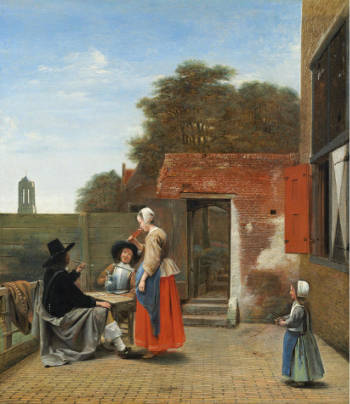
A Dutch Courtyard
Pieter de Hooch
1658/1660
Oil on canvas, 69.5 x 60 cm.
National Gallery of Art,
Washington D.C.
Although various locations have been proposed in the past, the most consistent candidate for the location of the scene of The Little Street has been the Voldersgracht, a narrow street that runs next to a canal in the center of Delft, where Vermeer was born. However, some art historians believe that despite the scene's realistic appearance, it could be a distillation of typical architectural elements gathered and skillfully woven together within the privacy of the artist's studio.
The century-old question has been recently addressed by Dr. Frans Grijzenhout, professor of Art History at the University of Amsterdam. Grijzenhout argues that the setting for the painting is on Vlamingstraat in Delft, where houses 40–42 now stand. Grijzenhout's entire theory is based on measurements he found in the Legger van het diepen der wateren binnen de stadt Delft (Ledger of the dredging of canals in the town of Delft), a document compiled from 1666 onward that records the widths of house frontages for tax purposes. Based on this map, the width of house number 40 is reduced to 4.75 meters. This discrepancy casts doubt on the reliability of Grijzenhout's theory. Either the Legger or the cadastral map is inaccurate.
Adding to the uncertainty, architectural historians believe the right-hand house in the painting predates the 1536 fire that ravaged Vlamingstraat, suggesting Vermeer's depiction may be of a different location altogether. Grijzenhout has created sketches based on his interpretation, yet these are criticized for potential inaccuracies in depicting the actual depth of the block between streets.
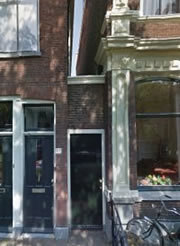
Vlamingstraat
Philip Steadman, the London architect and author of Vermeer's Camera: Uncovering the Truth behind the Masterpieces, examined Grijzenhout's hypothesis point by point and found several inconsistencies.
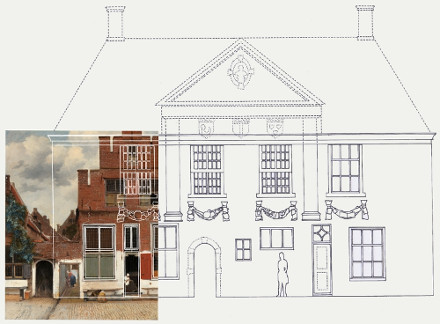
Elevation of the Guildhall of Saint Luke superimposed over The Little Street. See how the windows and door on the ground floor at the left coincide closely with the windows and door in The Little Street. These survive from the former Old Men's House building.
Grijzenhout speculated that the house on Vlamingstraat would have had particular resonance for Vermeer, since it was occupied at this time by Ariaentgen Claes van der Minne, one of Vermeer's aunts. However, Steadman suggests that Voldersgracht would have held greater meaning for the painter as it offered a view from his family home across to a building which, when he painted The Little Street, was on the verge of being converted for use by his profession's center, the Guild of Saint Luke.
Vermeer's childhood

New Church, Delft
Two children playing together in Little Street provide the sole depiction of childhood in Vermeer's oeuvre.
Very little is known about the artist's early days. His parents were married in 1615 in Amsterdam by Jacobus Taurinus, a prominent Calvinist and Orthodox Reformed Church Minister. His parents likely belonged to a significant group of people known as liefhebbers (supporters), or those who, for various reasons, chose not to adhere to the stringent membership requirements or harbored reservations about religious discipline.
Vermeer was baptized on October 31, 1632, in the Reformed Church (in the New Church) in Delft. Given the 12-year age gap with his sister, Gertruy, Vermeer might have felt akin to an only child. Yet, like all other children, he would have ice-skated in the winter, played kolf by hitting balls with a stick and fished in Delft's pristine canals. He also engaged in the annual public festivities that allowed children to let off steam.
Today, Vermeer's family background would fall into the lower-middle-class category. His grandparents couldn't read or write, and neither could his mother. He grew up in a spacious house that his father, Reynier, purchased after elevating his financial standing. Reynier appeared to be a diligent, hard-working man with a cautious approach to living and investing.
In the Netherlands, families were typically small and tight-knit, averaging three or four children. It was uncommon for close relatives, like grandparents, to live in the same household. The parenting style of the era was notably respectful and understanding. Children were taught values at home, where they typically resided until their mid to late twenties.
The public lives of Dutch women
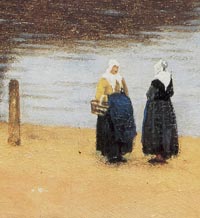
View of Delft (detail)
Johannes Vermeer
c. 1660–1663
Oil on canvas, 98.5 x 117.5 cm.
Mauritshuis, The Hague
Other than The Milkmaid and Little Street, as well as the tiny stand-in figures in View of Delft, Vermeer avoided depicting the mundane, day-to-day work routines or the public life of his women. Instead, he focused on moments of reflection such as reading and writing, as well as courtship and music-making.
Foreign travelers visiting the Dutch Republic often remarked on the conspicuous presence of women in public spaces. Dutch women were not only praised for their commitment to their families but were also reported to be independent and adept entrepreneurs, conducting business either under their own names or on behalf of their absent spouses. The accuracy of these frequently mentioned observations remains a topic of discussion.
Legally, Dutch women had notable advantages compared to their European peers. They had the right to inherit and bequeath property, and if they faced injustices during their marriage, legal remedies were available. Vermeer's mother-in-law successfully claimed a significant portion of her husband's wealth after enduring years of physical and emotional harm. Adultery, severe abuse, or intentional desertion could lead to a separation of "table and bed," effectively ending the marriage. Upon matrimony, a record of the assets both parties brought into the union was made. After the marriage ended, the initial amounts would be returned to their respective families. Profits or losses acquired during the marriage were typically split. However, a widow could decide whether to share in the gains or losses after her husband's passing.
Women had the right to enter into commercial contracts and create notarized documents. They were effectively empowered to engage in business activities. Some hailed from prominent trading families and held high regard. Yet, many of the most proactive businesswomen were either married or widowed, continuing their late husband's enterprises. Numerous Dutch paintings depict women running shops or market stalls.
Vermeer's grandmother, Neeltge Goris, was an uijtdraegster or second-hand goods dealer who settled the estates of the deceased. Paintings often featured in these estates.
17th-century tourism in Delft
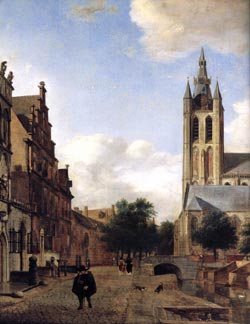
The Old Church on the Oude Delft in Delft (detail)
Jan van Heyden
1675
Oil on panel, 45 x 57 cm.
Nasjonalgalleriet, Oslo
By the late 1650s, when Vermeer painted The Little Street, Delft had become an essential tourist attraction. People from all over the Netherlands and abroad flocked to the city to admire its public and religious buildings. The tomb of William the Silent in the New Church (New Church), an elaborate marble edifice dedicated to the father of the United Republic assassinated by the Catholic Frenchman Balthasar Gérard, was especially significant.
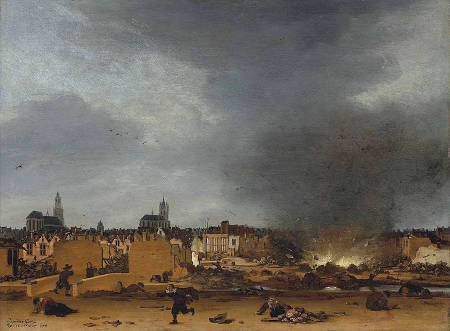
View of Delft after the Explosion of 1654
Egbert van der Poel
1654
Oil on wood, 36,2 x 49,5 cm
National Gallery, London
Another Delft tragedy, too, became an unexpected tourist attraction. On Monday, 12th October 1654, at half-past ten in the morning, the civic gunpowder magazine exploded, leveling several parts of the town. The explosion claimed the lives of more than a hundred people and wounded many others, setting a fire that engulfed many of the city's wooden constructions. Its force was so intense that doors in nearby towns slammed shut, and the blast was rumored to be heard as far away as the island of Texel, seventy miles north of Delft. Once word of the tragedy spread, both dignitaries and ordinary Dutch citizens arrived to bear witness. In time, the devastation itself became a draw for visitors.
Delft's proud and industrious citizens strived to repair the destruction swiftly, but remnants of the disaster lingered. This event inadvertently created a market for townscape paintings of the affected areas. Egbert van der Poel, who lived near Rembrandt's renowned student Carel Fabritius, was one such artist. Though he survived the explosion, he lost his daughter and possibly other family members. Van der Poel painted numerous depictions of the disaster, sometimes illustrating the actual explosion and other times its aftermath. While it remains uncertain if he directly witnessed the event, he eventually earned the moniker "the painter of fire."
In preserving the memory of the explosion, the Delft town council chose not to rebuild certain structures. It's probable that some cracks on the building to the right in The Little Street resulted from the blast.
Visitors also frequented Delft for its inviting atmosphere, its intimately scaled spaces and its picturesque, tree-lined canals. Much like today, the town provided ample opportunities for leisurely walks past well-kept shops and private homes.
Dutch children

Emblem from Roemer Visscher's
Sinnepoppen, Houghton Library
Harvard University
Travelers to the Netherlands were often surprised by the gentle treatment of children. There seemed to be an abundance of affection, with many finding the custom of giving young children a good-night kiss disconcerting—there seemed to be all too much kissing and cuddling going on. Some sterner Calvinists even looked down upon it. Several historians have theorized that European parents may have emotionally distanced themselves from their offspring due to high infant mortality rates. In defense of their affectionate behavior, Dutch parents have been quoted as asking, "Does anyone spoil their own face or cut off their nose?"
However, life was starkly different for impoverished or orphaned children. Many were subjected to child labor well before reaching the age of ten, and their education was often disregarded by their overseers. In Delft, orphans were made to work in textile shops. The working conditions were so poor that many did not survive.
Regardless, the Low Countries had a longstanding tradition of portraying children in art. Jan Brueghel created a significant piece that depicted dozens of children at play, essentially cataloging the children's games of that era. While Vermeer might not have been directly inspired by Brueghel's work for The Little Street, he was likely familiar with the Flemish artistic tradition.
Dutch homes

A Woman Reading a Letter and a Woman Sweeping
Pieter Jansessens Elinga
Late 1660s–early 1670s
Oil on canvas, 83.7 x 100 cm.
Städelsches Kunstinstitut
Frankfurt am Main
From both anthropological and architectural perspectives, homes in the Netherlands gained significant importance in the second half of the 17th century. Scenes of domestic life flourished, with women frequently portrayed. This domestic setting became the woman's responsibility and spiritual domain, while the public world, now distinctly separated from the home, was seen as the man's domain. Paintings often depicted women in roles associated with homemaking, nurturing and embodying the core values of family life.
However, unlike his peers, Vermeer did not portray families, children, or elderly individuals, with rare exceptions in pieces like The Little Street and The View of Delft.
Unlike the communal living arrangements of the Middle Ages, the 17th-century Dutch home began to individualize the functions of rooms, although beds could be found in any room. As you entered one of these homes, you'd step into the voorhuis—the front room or entrance hall, where visitors were welcomed, often lavishly adorned with art and ceramics to display the family's wealth.
Beyond the voorhuis lay the achterhuis, a more intimate living space, perhaps even containing the house's kitchen, with its substantial hearth, ready for both daily meals and grand feasts. Stairs would lead to the upper floors, revealing slaapkamers, or bedrooms. Here, you might stumble upon the bedstede, a unique bed built into a cupboard, which not only saved space but also provided a cozy refuge during cold nights.
Some homes boasted an opkamer, a slightly elevated private space, ideal for storage or a private retreat. Meanwhile, the attic or zolder often stored a myriad of household items, sometimes even accommodating servants.
Outside, if you were lucky, you'd find a binnenhof, a tranquil inner courtyard, while merchants often had a pakhuis or warehouse attached, a testament to the bustling trade of the period. With canals lining many streets, goods could be directly transported to these storerooms.
In the past, the designers of buildings were deeply involved in the construction process. Often described as masons or stonecutters, they were essentially master-builders, personally participating in the execution of their designs. The modern concept of an architect who oversees and coordinates all aspects of construction hadn't emerged. Architecture, as a distinct profession, wasn't recognized.
A view from the back of Mechelen

The only image of the façade of
Mechelen dates from an engraving
of c. 1720 by Leonard Schenk.
Mechelen was one of the largest
constructions on the Market Square.
Even though a few years ago the art historian Frans Grijzenhout proposed Vlamingstraat——specifically at the current addresses 40-42 that was a less affluent area during Vermeer's era—as the most probable location of The Little Street, it was traditionally held that Vermeer painted the scene from the rear side of the second floor of his father's inn, Mechelen, situated on the Market Place.
From a contemporary engraving, Mechelen appears to have been a spacious house, providing ample room for the public-house business on the ground floor. Vermeer's industrious father was listed at the Guild of Saint Luke as an art dealer and also reportedly worked with "caffa," a fabric resembling satin used extensively for upholstery, clothing and draperies. Mechelen no longer stands, even though an inaccurate commemorative plaque exists on the side of the neighboring building. The alley was expanded to accommodate a fire truck. One of the most detailed portrayals of Mechelen's facade comes from an early 18th-century engraving by Leonard Schrenk.
When Vermeer married in 1653, records show he resided in Mechelen. The same document notes that his soon-to-be wife, Catharina Bolnes, "also lived there." John Michael Montias, who suspects a clerical oversight, posits that it is highly improbable for Catharina Bolnes, with her strong Catholic ties on her mother's side, to have cohabited with Vermeer in Mechelen prior to their marriage. Conversely, art historian Kees Kaldenbach believes that Catharina might have chosen to live with Vermeer, pressuring Catharina's mother, Maria Thins, to tacitly approve their relationship.
Drawing inspiration from Pieter de Hooch
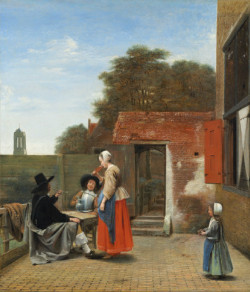
A Dutch Courtyard
Pieter de Hooch
1659–1660
Oil on canvas, 70 x 60 cm.
National Gallery of Art, Washington
As Walter Liedtke pointed out, the painting's essential subject is not architecture for its own sake but an old house and the kind of family that would have lived there. In this regard, the picture is nearly the antipode of Jan Steen's so-called Burgher of Delft and His Daughter, of 1655, which portrays known individuals—the widowed merchant Adolph Croeser and his fashionably dressed daughter Catharina—in front of their fine house on the best street in town, the Oude Delft. Instead, Vermeer's piece aligns more with Pieter de Hooch's style depicting women in a courtyard of an ordinary house, overseeing a child. While both compositions share similarities, Vermeer's painting provides a frontal view with an emphasis on the detailed texture and tone of the masonry walls.

A Courtyard in Delft at Evening: a Woman Spinning
Pieter de Hoogh
1657
Oil on canvas, 69.3 x 53.8 cm.
The Royal Picture Gallery, Buckingham Palace
De Hooch's works from around 1658 might have inspired these qualities in Vermeer's painting. However, Vermeer presents it as if viewing from afar, perhaps across a canal, making it unique and not merely a topographical townscape. Here children play (and perhaps draw?) on the pavement while their mother sews in the doorway and a maid washes (she appears to bend over a tub) in the alleyway. On the other hand, De Hooch's fondness for describing schilderachtige (painter-lik' or picturesque) motifs is taken further, becoming a dominant concern, as in Emanuel Murant's views of cottages, castles and villages and in works by other artists active during the 1650s and 1660s, including the Delft painter Daniel Vosmaer.
A "fake" Vermeer cityscape
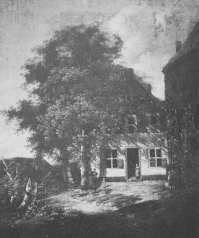
Rustic Cottage
Dirk van Lann
Whereabouts unknown
Dirck Van Laan's Rustic Cottage was erroneously held to be an authentic Vermeer by Thoré-Bürger, the French art historian who is considered to be the rediscoverer of the master. Van Laan' was, however, the Frenchman's his Achilles's heel. In his 1866 article, he included an engraved reproduction of the painting and reiterated his belief that it was "indisputably a landscape by Vermeer of Delft," which he also believed was referenced in the Dissius sale of 1696. In Thoré-Bürger's view, this was the third authentic exterior by Vermeer, following the View of Delft and The Little Street. He defended this position with intricate logic, stating, "This delightful scene is more a landscape than a view of a house, just as the painting in The Hague is more a landscape than a cityscape." It's evident that Thoré-Bürger was keen on categorizing Vermeer as a landscape painter. Unbeknownst to him, in his card index, he had confused Vermeer of Delft's original works with signed pieces by, among others, an artist with a similar name to Vermeer: J[oh]an van der Meer.Van Laan's painting cannot be considered a forgery because the artist probably had not even the slightest idea that his work would later be attributed to Vermeer.
At the annual Paris Salon of 1866, an event that drew significant public attention to Vermeer's previously unrecognized work, Rustic Cottage was displayed alongside other genuine and questionable pieces attributed to the artist. Van Laan's work was not only a favorite with the general public; it was also considered one of Vermeer's finest by connoisseurs. Zacharie Astruc, the French sculptor, painter, poet, art critic and friend of Edouard Manet, highlighted its deliberate simplicity, noting, "One hears voices. Such a private life, so eloquently portrayed." Van Laan created another version of the piece that closely resembles Vermeer's Little Street.
Jean Marie Chaumelin, another French art critic, journalist and writer, praised the depiction of light in both paintings, but particularly in the "ravishing" Rustic Cottage. He described the golden rays of sunshine glittering through the tree onto the white walls of the cottage, and the skillful execution of the View of Dunes, another landscape that briefly flew falsely under Vermeer's flag.
Vermeer: a conservative painter for a conservative town
Concerning the laid-back atmosphere in Delft, art historian Peter C. Sutton wrote: "The conservative spirit seemed to be reflected in the layout of the city itself. Whereas most 17th-century Dutch towns were a tangle of narrow streets and alleyways, Delft had a clearly organized ground plan since the Middle Ages. A regular system of canals and streets, meeting at right angles and forming a grid, culminated in the large rectangular marketplace where the New Church and Town Hall still stand. The dominant impression of the city, then as now, was of long vistas bordered by low brick dwellings. In his Journal de Voyayes of 1665, the French diplomat and diarist Balthasar de Monconys observed, 'Les rues sont toutes si droictes et si régalières, qu'on sait d'abord tous les endroits' (The streets are all so straight and so regular, that one immediately knows all the places). Delft's chronicler, Dirck van Bleyswijk, also claimed that Delft was the cleanest of all Dutch cities. The town's neat and orderly appearance, so suited to the mentality of the inhabitants, found its clearest expression in the works of De Hooch and his colleagues."
The conservative atmosphere of Delft seems to have suited Vermeer's artistic temperament. He cannot be considered a particularly innovative painter, and he seems to have had relatively little influence on his contemporaries. He was a professional latecomer of sorts whose work presented no revolutionary or provocative content. He embraced the basic theoretical tenets of the art of his time and adhered to the common technical procedures of his school, even though he worked outside the history painting idiom which, however, had been abandoned by many Dutch painters.
Vermeer identified himself with his native culture. His canvases are a direct confirmation of the moral and social values held by the majority of his fellow Dutchmen. His political allegiance is amply demonstrated by the maps of the Dutch Republic which populate his works, in particular, by the exquisite treatment reserved for the map of the Netherlands which prominently hangs as the backdrop in The Art of Painting. In the early Officer and Laughing Girl, the carefully integrated relationship between the figures and the map expresses, as Arthur K. Wheelock Jr. wrote, not only an "unmistakable pride in the homeland but also the communion between the people who live there and enjoy the fruits of peace." Moreover, he portrayed the highest cultural and scientific achievements of his countrymen without a trace of irony.
In particular, Vermeer identified with his native Delft. Anyone who has had the chance to directly view the View of Delft or the Little Street cannot deny the empathetic treatment of these subjects. No doubt, Vermeer was the cleanest painter in Delft, and he may have been its most loyal as well. While almost every other painter had left Delft by the late 1660s for prosperous Amsterdam, Vermeer remained bound to his beloved birthplace until the day of his premature death.
Jacobus Vrel: follower or precursor?
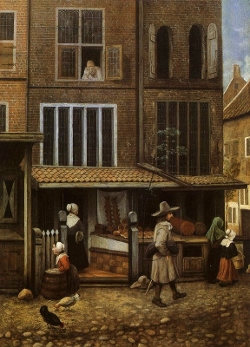
Street Scene with Bakery
Jacobus Vrel
Oil on panel
Private Collection, New York
Although Vermeer was celebrated in his own time among a circle of elite art collectors, the impact he made on his contemporaries and subsequent painters is surprisingly faint. No evidence exists to suggest he ever took on an apprentice, and none of his many children seemed inspired enough by his craft to pick up a brush and paint. One of the few artists with any connection to Vermeer—albeit uniquely stylistic—is Jacobus Vrel, an elusive figure who has only recently been acknowledged. Vrel stands out as one of the most idiosyncratic minor-masters of his era. Some observers have speculated that he might have been an amateur or even a "Sunday" painter.
There are no records of Vrel's personal life, with his name only being preserved through the signatures on some of his pieces. His limited body of work includes 38 "minimalist" interiors and serene street scenes, all exuding a raw, almost naïve style that resonates with contemporary tastes.
Some of his works bear his signature or remnants of signatures that were modified to resemble those of Vermeer or Pieter de Hooch, leading to confusion between their works. Interestingly, Thoré-Bürger, the French art critic credited with Vermeer's "rediscovery" in the 1860s, discussed Vermeer's acclaim as a townscape artist based mainly on paintings that were, in fact, Vrel's handiwork.
Though self-taught, Vrel's style shows certain affinities with the Delft and Amsterdam artists, namely Pieter de Hooch, Vermeer and Pieter Janssens Elinga. However, some experts believe he likely resided in a smaller town, perhaps Zwolle, instead of a significant art hub. Features in his street scenes hint at ties to Haarlem, Friesland, Flanders, or even the lower Rhineland. His only painting with a clear date, from 1654, suggests that Vrel's interest in household themes and lighting nuances predated similar explorations by Delft artists, inducing some art specialists to nominate him as Vermeer's "forerunner." Still, the early inclusion of two of his paintings in Archduke Leopold Wilhelm of Austria's collection inventory attests to his contemporary acclaim, especially since the archduke's curator was the esteemed Flemish painter David Teniers the Younger. Notably, the date on his piece, Interior with a Woman at a Window (1654), confirms he was producing such dated works four years ahead of any known pieces by De Hooch in the Delft interior or courtyard style.
Painting bricks

Since the outset of his career, Vermeer shunned the microscopic detail of the fijnschilder (fine painter) technique of his Leiden colleagues. By comparison, Vermeer's painting is broad and, at times, starkly simple. Although there are passages of exquisite technique in his 35 (?) pictures, detail is always subordinated to the impression of the whole.
Another characteristic of Vermeer's approach to painting was his search to achieve the maximum visual effect with the most economic pictorial means. In the Little Street, for example, he was able to accomplish the life-like effect of worn masonry with the simplest of procedures. Instead of painting individual bricks one by one, he first laid in with a large brush a more or less uniform layer of thick reddish-brown paint on the part of the building's façade covered by bricks. Here and there he introduced a hint of gray to avoid producing a mechanical effect. Once dry, he carefully defined the mortar between the bricks with thin lines of light gray paint applied with surprising verve. Later, a few bricks were heightened with orange to create some sense of relief while others are darkened to give a weathered appearance.
Dutch bricks of the time were typically deep-red to orange hues, a result of the region's soil composition. These bricks, though smaller than many might expect, allowed for intricate designs and patterns. This led to remarkable brick facades that reflected the prosperity and civic pride of the era.
As for the laying patterns, they were diverse. The "cross bond" and "Flemish bond," which alternate bricks between headers and stretchers in one course, were prevalent. Another favorite was the "English bond."
In the facade of The Little Street it is possible to make out—although not consistently—the English bond, which is considered the strongest and most widely used brick bond in construction work. It consists of alternating courses of headers and stretchers. In this arrangement, vertical joints in the header and stretcher courses align with each other.
Schilderachtig and Vermeer's house
Curiously, even the earliest reference to the present picture describes it as a "house" rather than a "street." As in a few other Dutch townscapes, the intimacy of domestic life in Vermeer's picture prevails over brick-and-mortar architectural details. This sentiment must have resonated with viewers 350 years ago. In that era, Vermeer's house wasn't a luxurious townhouse emerging on the fashionable Oude Delft. Instead, it was a modest dwelling from a bygone era that had endured the city's challenges, old but well-preserved.

Landscape with a Dilapidated Farmhouse
Jan van Goyen
1631
Oil on panel, 40 x 54 cm
The Hague, Mauritshuis Museum
To anyone who observed The Little Street in 17th-century Netherlands, the term schilderachtig might come to mind. Translating to "picture worthy" or "worthy of painting," it aligns closely with the modern term "picturesque." However, it's important to note that in the 17th century, European painting was greatly influenced by Italian art concepts. One such belief was that the merit of a painting was tied to the importance of its subject. Thus, an old woman, a weathered farmhouse, a rural peasant scene or Vermeer's simple houses would have faced criticism because grand biblical or historical narratives were deemed the only worthy subjects of the artistic endeavor.
Yet, Dutch painters, many of whom viewed themselves as artisans rather than artists, were more influenced by the art market than by prevailing art theories. Without the constraints of aristocratic or ecclesiastical oversight, they were free to explore subjects that appealed to them or that had market value, regardless of the classical status of the subject in painting hierarchies.
Schilderachtig conveyed values dear to the Dutch, such as rustic simplicity, authenticity and an appreciation for the unembellished. The idyllic worlds of the past, the odd, the unusual, or even the visually challenging became worthy subjects for painters. Artists like Rembrandt and Jan van Goyen found audiences for depictions of aged farmhouses outside urban centers, while Vermeer captured the essence of an aged home along a narrow Delft canal.
Listen to period music
![]() Antonio Vivaldi
Antonio Vivaldi
Le Quattro Stagioni, op 8, no 1 "La Primavera," Largo [1.29 MB]
http://www.amazon.co.uk/gp/product/B001NA5MPE/sr=1-11/qid=1258623066/ref=sr_digr_11?ie=UTF8&qid=1258623066&sr=1-11

